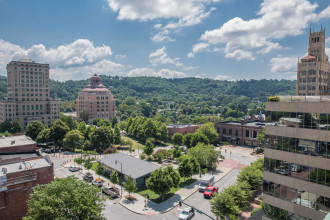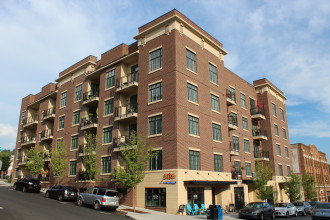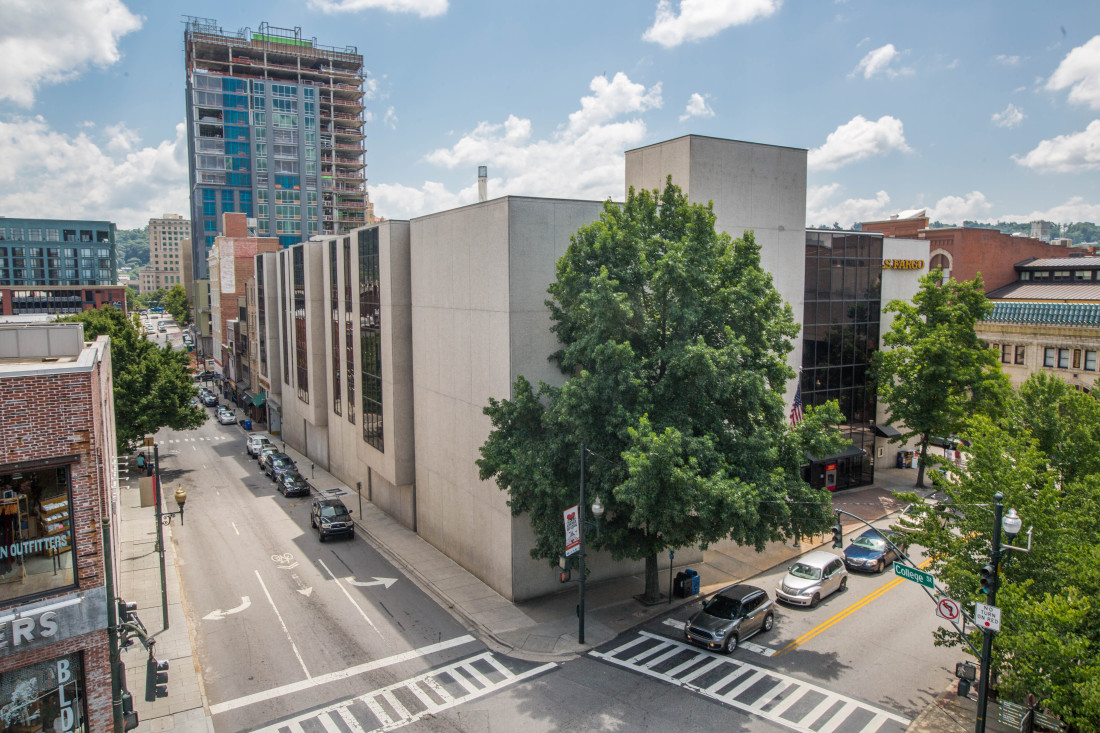In tandem with the majestic Blue Ridge Mountains that surround it, Asheville’s architecturally rich, pedestrian-friendly downtown draws visitors throughout the year as well as an increasing number of new residents. But as the city continues to grow and evolve, new construction is changing downtown’s look and feel in ways that not everyone is happy about.
“I think that, appropriately, there is criticism of some of the new stuff we’re seeing,” concedes Jack W.L. Thomson, executive director of the Preservation Society of Asheville and Buncombe County. “So much of it is driven by the marketplace and how to capitalize on the use of a piece of real estate … instead of the potential contribution that architecture can have to the public realm, to the entire city.”
Even attempts to harmonize new construction by incorporating more traditional design elements have their critics. “I think you diminish what’s historic when you start to just copy it. Downtown starts to feel like a theme park,” says local architect Laura Berner Hudson.
And as the cost of construction materials continues to rise and more new buildings are erected within the downtown historic district, the direction Asheville’s evolving urban style takes may have a significant impact on the city’s future.
Historical foundation
“Downtown Asheville is a history museum of sidewalks. It’s a place for the visitor to experience history by walking the sidewalks, observing the architecture,” says Thomson. For him, the art deco structures from the 1920s, including such memorable creations as City Hall, are “the evocative expression of architecture in downtown Asheville. There are pockets of art deco across the country, but for this relatively small mountain city to have such exuberant specimens is pretty special,” he says.
At the same time, he continues, “Probably the largest inventory of historic architecture downtown [consists of] relatively more modest examples from an earlier period, from the 1890s through the teens, of this two- and three-story brick mercantile architectural inventory. And I feel like those somewhat understated historic buildings are kind of the glue or the fabric that holds these really expressive art deco examples together.”
Rounding out downtown’s architectural mélange is the Gothic Revival style of the Jackson Building and the Grove Arcade, which Thomson says were “very flamboyant for their time period.” Also key to the central business district’s aesthetic character are unusually shaped structures such as the Miles Building and, adjacent to it, one of the few flatiron buildings outside of Manhattan. Those designs, he says, were mandated by Asheville’s topography, which influenced street layouts and oddly drawn lots.
Thomson calls the Preservation Society “a relatively small and modest advocacy organization” that is “working in a high-pressure development scenario.” Thus, the primary concern is potential threats to historic buildings. “We consider historic resources nonrenewable resources. Once they are gone, they’re gone,” he points out.
As community support for the group’s efforts continues to grow, Thomson hopes it can become more influential in assessing the quality and scale of new construction. In the meantime, however, “What we hope is that the new architecture will be of a quality that preservationists 50 years from now will want to defend. I think that the jury is going to be out on that for several decades.”

Striking a balance
There are still some structures downtown representing later eras, such as I.M. Pei’s Akzona/Biltmore Building (1980), and even the new designs sometimes incorporate or reference older styles. The current makeover of the circa 1965 former BB&T Building, for example is abandoning the original stark, glass-and-steel exterior in favor of a more ornate and varied approach. In its new avatar as “The Arras,” it will feature 128 hotel rooms, 54 condos and a pair of restaurants.
Hudson, however, says she’s seeing a lot of what she calls “art deco lite” and other “themed” buildings featuring external ornamentation that has nothing to do with the structure’s actual function. “If you want to build a real replica out of stone with a mason, go for it: Make that gorgeous,” she argues. “But you see these buildings that have these big, huge, oversized cartoon cornices. They’re made out of styrofoam covered in stucco. What’s the point in that? There’s no authenticity. It’s not a creative interpretation. … The answer is not to go back and just re-create the past: It’s to put more effort into what we’re doing today.”
Thomson feels this “tribute aesthetic” may have a place in today’s downtown, though he stresses that it “still needs to embrace a contemporary base line or foundation of the design. I think there’s room for both, but it can be tricky,” he points out. “We’re a community, in general, that wants to embrace the notion of allowing for good contemporary architecture and new construction. We should honor and respect our historic architecture. We should leverage it for our economy, which is what we do, but a city really needs to be dynamic. And so allowing for new design to come in without the risk of loss of historic resources, I think, has a strong merit.”
One example of a creative solution to the past vs. present conundrum is the Asheville Art Museum’s current renovation and expansion project. Developed by the New York City-based Ennead Architects, it will preserve the current facility’s historic elements while juxtaposing a glass box facade that represents a thoroughly modern approach.
Both Hudson and Alan Glines, assistant director of the city’s Planning and Urban Design Department, praise the design. “It’s something that’s contemporary and today, and it will be beautiful in contrast with everything that’s happening around it,” says Hudson. “I feel like Asheville’s a bold city. I wish we had bolder buildings.”
Economic drivers
Earlier this year, notes Glines, the Downtown Commission — which makes recommendations to City Council concerning downtown issues and carries out design review on major development projects within the central business district — announced that its priority over the next three years will be to encourage downtown residential development “of all stripes and price points.”
Sage Turner, chair of the Downtown Commission, says the agency intends to accomplish that goal by continuing to work with developers to incorporate mixed-income housing, urging staff and Council to fund needed infrastructure and working “with other boards and commissions on initiatives like the land use incentive grant that provides future tax rebates based on location and access.”
Up till now, much of the residential construction in the area has been limited to four to six stories, and while the code allows developers to build higher, doing so may not make financial sense.
“After seven stories,” says local architect Peter Alberice, “typically a project becomes classified in the building code as a high-rise.” And once that happens, “There are a lot more code restrictions that add to the cost of the project. There’s not really a mandate, but it’s one of those self-regulating issues that the building code brings.”
Parking is another complex issue. Particularly with condos, notes Alberice, “The height and size of a building … is determined by how much secure parking can be provided within the project.” Building the parking, he explains, is “more expensive than what you could ever sell the spaces for, so there’s a balance between what is basically something you have to have to sell the units, and then how many units can be put in the building.”
But the decision to keep these new structures in scale with the existing ones, notes Glines, “will shape how we experience downtown for years to come, because those buildings will be there for a good long time and you can’t really add on, at least with today’s technology.”
Asheville architect Michael McDonough, a former Downtown Commission chair, says a contractor told him recently that the price of many construction materials has risen 40 percent.
“It’s getting more and more challenging to design and build a building that has high-quality materials and high-quality design and allows a developer to make money,” McDonough points out. “If we want nice buildings, we have to sell them or lease them at higher prices to pay for the nice materials and design. … Unfortunately, there’s not a lot of inexpensive new housing downtown, but I think the architecture would have to be very tame, with a lot of synthetic stucco and cement panels and all that in order to bring down costs.”
In terms of standout new residential designs, both Glines and McDonough praise the building at 150 Coxe Ave., which houses the ZaPow gallery on the ground floor and The Lofts at South Slope above. McDonough, who reviewed the plans while serving on the Downtown Commission, says the developer’s pivot from a combination parking garage/apartment building to a mixed-use facility that includes ground-level commercial spaces led to a better overall design.
If the city provided more parking as part of the infrastructure, he argues, “It would free up developers to say, ‘Let’s put a building very close to it … and then it can become a better building because it can be designed for people rather than cars.’”
And as people become less dependent on personal automobiles in the years ahead — and, thus, on having on-site storage for them — McDonough sees great potential for this formula downtown.

Guiding principles
Other key factors that are helping drive the look of the city center are the Downtown Master Plan and Downtown Design Review Guidelines, which City Council approved almost a decade ago. Before that, notes McDonough, there really were no downtown design standards or height restrictions. Many of the guidelines, he explains, “were adopted into the Unified Development Ordinance. Compliance is mandatory as part of the zoning staff review and as reviewed by the Downtown Commission.” They’re aimed, he says, at creating buildings that have “a healthy relationship with the public realm, specifically with regard to sidewalks and pedestrian activity.”
Ironically, however, the master plan also curtailed City Council’s ability to review proposed developments, limiting it to only the very largest projects.
In the wake of the 2008 recession, says McDonough, “There was not a lot of construction activity downtown for a few years, and then things started to crank up. So we are now seeing, 10 years later, the physical results of that master plan and guidelines that were adopted. I think it is instructive to look at the buildings that were created. Were they improved? Are they better buildings because of the downtown master plan and those guidelines? That judgement has less to do with the aesthetics of the building and more to do with how it fits into the context.”
There’s also the Planning & Zoning Commission, which Hudson chairs. Although it’s not a design review board, it can get involved when a proposed project requires conditional zoning. The commission, she says, tries not to be overly prescriptive in its design recommendations, but in those instances it’s within P&Z’s purview to make aesthetic suggestions.
“What I think the city actually champions,” says Hudson, “is an independent artistic spirit that is evident in many of our historic buildings, and we celebrate that by preserving and restoring some of the most spectacular examples of Asheville’s authentic design. The problem is that cities are living organisms that cannot be frozen in a certain decade. So I believe the best way to honor the ‘historic flavor’ is to channel that independent artistic spirit and add new buildings that future generations will appreciate.”
A place for everyone
Still, what happens when the new construction starts to outnumber the historic structures? Or when the scale of the high-rise hotels simply overwhelms the older four- and five-story buildings? And because of its compact size, is Asheville’s downtown at particular risk compared with larger historic districts in bigger cities?
“Of course we are concerned about the balance between new and old and how it impacts the attractiveness of our city,” says Thomson. But the city’s ability to regulate development is limited.
“Even though the old downtown core is a national registered area, it’s not a local district,” Glines explains. In local historic districts such as Montford, he continues, “The Historic Resources Commission can dictate the style and detail down to the color of the siding.”
And while McDonough says that “Many on city staff and appointed commissions are concerned about the historic character being overwhelmed by new construction,” finding a solution isn’t easy. “There have been several efforts by the Historic Resources Commission to explore a historic district downtown to offer regulation and control,” he notes, “but this takes buy-in by a lot of property owners.”
These concerns aren’t limited to the central business district, either. “One should not overlook the importance of surrounding historic urban neighborhoods and the contribution they make to the attractiveness of the downtown,” Thomson points out. “Protecting those areas is just as important. The demolition threats in unprotected neighborhoods next to downtown will be tremendous if the current market trends continue. Even historic suburban neighborhoods like Lakeview Park are seeing tear-downs today.”
And in the meantime, what about tourism? If downtown’s historic flavor — which the city actively championed for decades and which has played a key role in creating the current boom — is compromised to the point that the city center ends up looking like Anyplace, USA, will the tourists decide to go elsewhere?
Some people, notes McDonough, “might have concerns about tourism, but most I know (and me) do not see any obligation or desire to make decisions based on what tourists might prefer, or might do, with regard to how we manage growth downtown. In fact, we were more concerned about the negative effects of tourism, most recently in terms of long-term housing being replaced by short-term rentals.”
Hudson, meanwhile, maintains that “if we mimic history to keep tourists happy, we will become another Williamsburg and will have lost the very thing that makes us special.”
In the end, she believes, downtowns should be “a place for everyone,” and public spaces play a key role in civic life. For this reason, she encourages residents with an interest in downtown Asheville’s architectural future not to lose sight of their ability to influence it by attending Planning & Zoning and Downtown Commission meetings, writing letters to local officials and voicing support for new, innovative designs.
“We have more potential than we realize to make a statement, to be the artists and the risk takers that we consider Asheville to be,” Hudson asserts. “Not everyone sees meaning in architecture, but we perceive it whether we realize it or not. It reflects back to us.”






“Architecturally rich”?
For older buildings in town , sure.
Otherwise, give up Arnaudin.
I call thee out as a hotelier collaborator who would
gentrify everyone here from 1784 for clickbait.
Gross.
huh? did Williamsburg Va lose the very thing that made it special ? who knew ?
Pt 2:
Q: How will new downtown construction affect Asheville?
A: How about welcome to Tourist/Hipster/Retiree Dollywood?
Karl Marx, how I miss thee.
You are proven correct.
The most interesting new architecture in the area tends to be residential, specifically homes where the person paying the money lives with and in the result. That doesn’t apply so much to hotels or condos that are built to fit a budget and a profit margin.
The question of architectural style, though, is tangential to what happens when downtown acreage currently devoted to surface parking or wooded areas or small buildings on relatively large lots gets turned over to developers. Nobody begrudged, for instance, the late Mr Wells of the Well-Groomed Barbershop selling up after a lifetime of serving his community — the actual sale took place shortly after his death this year — even though that little pink shop on a quarter-acre will be replaced by a garish condo block. We got a preview of that when the Aloft was dumped on Biltmore. We’re going to see a lot more of that in the years to come, and while adding density is generally a good thing, extractive density is not.